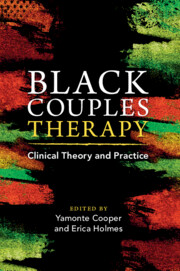Book contents
- Black Couples Therapy
- Black Couples Therapy
- Copyright page
- Contents
- Figures
- Tables
- Contributors
- Foreword
- Acknowledgments
- Introduction
- Part I Race, Racism, and Identity
- Chapter 1 Internalized Stereotypes and the Impact on Black Couples
- Chapter 2 The Role of the Strong Black Woman Schema in Black Love and Relationships
- Chapter 3 Black Same-Gender-Loving Male Couples’ Health within an Afrocentric Psychological Paradigm: The Influences of Spirituality and Religion
- Part II Foundations for Healthy Coupling
- Part III Adapting Major Therapeutic Approaches for Work with African American Couples
- Part IV Sex and Intimacy
- Part V Special Topics
- Index
- References
Chapter 1 - Internalized Stereotypes and the Impact on Black Couples
from Part I - Race, Racism, and Identity
Published online by Cambridge University Press: 27 July 2023
- Black Couples Therapy
- Black Couples Therapy
- Copyright page
- Contents
- Figures
- Tables
- Contributors
- Foreword
- Acknowledgments
- Introduction
- Part I Race, Racism, and Identity
- Chapter 1 Internalized Stereotypes and the Impact on Black Couples
- Chapter 2 The Role of the Strong Black Woman Schema in Black Love and Relationships
- Chapter 3 Black Same-Gender-Loving Male Couples’ Health within an Afrocentric Psychological Paradigm: The Influences of Spirituality and Religion
- Part II Foundations for Healthy Coupling
- Part III Adapting Major Therapeutic Approaches for Work with African American Couples
- Part IV Sex and Intimacy
- Part V Special Topics
- Index
- References
Summary
This research investigated patterns of African American couples’ positive and negative stereotyping and perceptions of couple adjustment and examined the relationship between demographic variables and African American couples’ positive/negative stereotyping of each other and couple adjustment. Respondents (n = 142; 101 females, 41 males) were 18 years or older, second-generation African Americans in a heterosexual relationship. The significant findings in this study were as follows: (a) older age is correlated with negative stereotypes of Black females and of Black males; (b) women who had a higher education endorsed more stereotypes of negative Black females than those who did not complete high school; (c) females had higher negative stereotypes of Black women and Black men than males; and (d) both being in a committed relationship and holding positive stereotypes related highly to overall adjustment in this sample of African Americans. Implications for further research and clinical work with African American couples are discussed.
- Type
- Chapter
- Information
- Black Couples TherapyClinical Theory and Practice, pp. 11 - 37Publisher: Cambridge University PressPrint publication year: 2023

